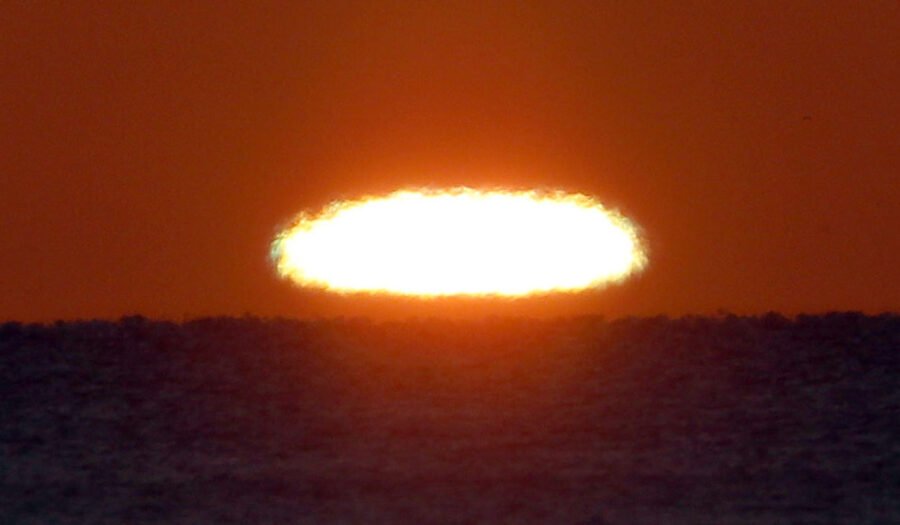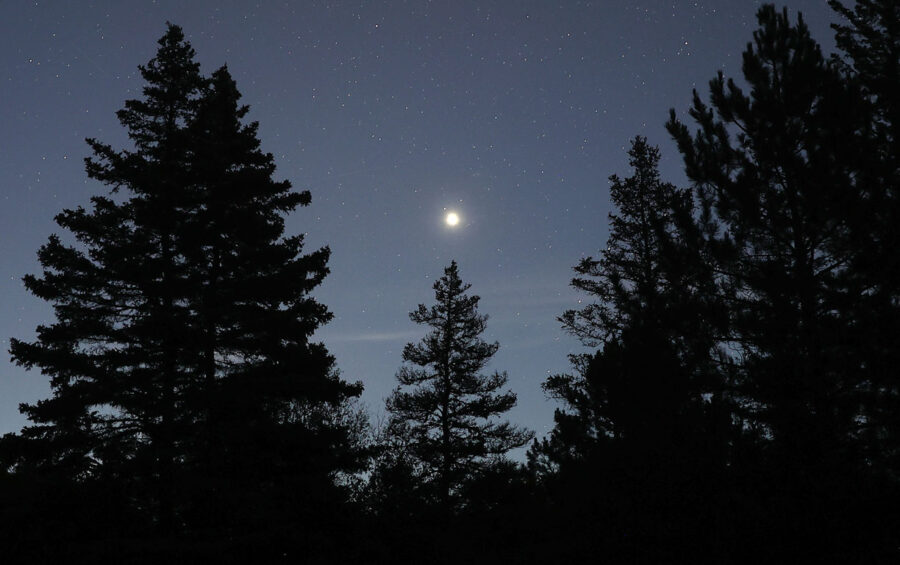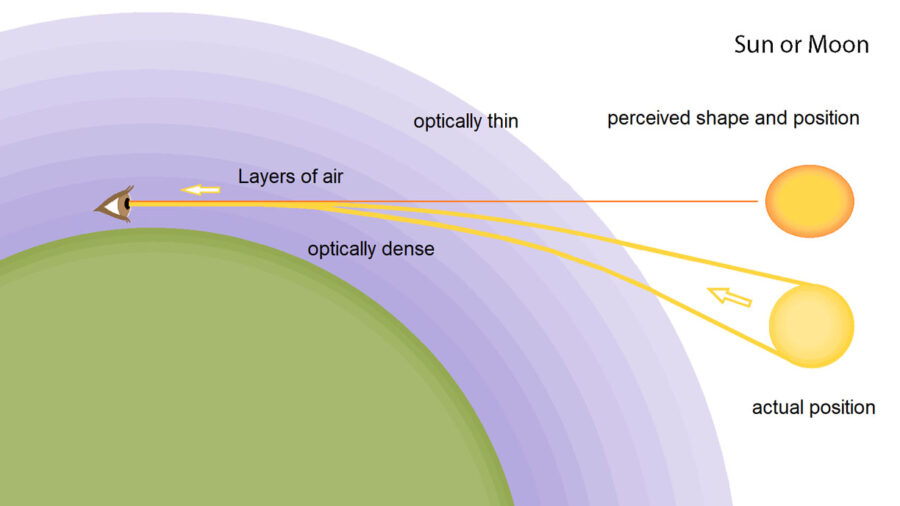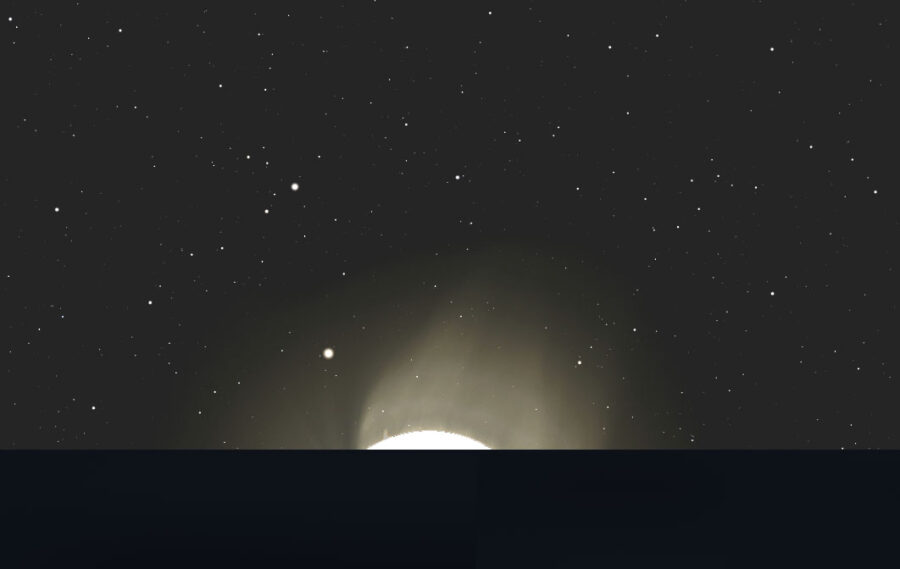
Bob King
Astronomical cycles acquaint us with the inevitable. That's what I'm thinking right now as we approach the first official day of fall (spring in the southern hemisphere), also known as the autumnal equinox. At 2:49 a.m. EDT, the Sun will cross the celestial equator going south and won't stop its descent until it bumps into the winter solstice on December 21st.
The celestial equator is a projection of Earth's equator on the sky. On that special day, the Sun will pass directly overhead at noon for residents living along the equator, from Nairobi to Quito to Singapore. At local noon, when the Sun passes overhead, residents won't be able to avoid stepping on their shadows. On the same day at the North and South Poles the Sun scrapes completely around the horizon. And no matter where you live except the poles it rises due east and sets due west.
At both the spring and fall equinoxes, the Earth's axis tilts neither toward nor away from the Sun but sidelong. Day and night momentarily strike a balance, each of them 12 hours long on this day, so neither one of them has the upper hand. That's why we call it the equinox, which literally means "equal night." Right?
Don't believe it. There's more to daylight on the equinox than you might think.
The Sun's Disk

Bob King
Even on the equinox, daylight still edges out night for two reasons. First, the Sun is a disk, not a point source. If the Sun were simply a more brilliant version of Venus, all of it would rise in one pop. Instead, sunrise is defined as the moment when the Sun's upper edge breaches the horizon. Since the solar disk is about ½° in diameter, its full disk takes between 2.5 and 3 minutes at mid-latitudes to clear the horizon. Similarly, sunset is the moment the trailing limb finally touches the western horizon. That adds another 2.5 to 3 minutes of sunshine at day's end. The result is a total of approximately 5 to 6 minutes of additional daylight. By the way, this is true for every day of the year, not just on the equinox.
As one approaches the Arctic at the time of the fall equinox, the Sun's angle of ascent becomes shallower and shallower. In Alert, Nunavut, the northernmost continuously inhabited place in the world, it takes more than 16 minutes from the moment of sunrise until the Sun clears the eastern horizon! At the equator — the opposite extreme — the Sun rockets straight up from the due-east horizon and extricates itself in just over 2 minutes.
The Earth's Air
Adding to the complexity is the fact that Earth has air. Consider atmospheric refraction, in which light rays are bent when they pass from a less dense medium (outer space) into a more dense medium (Earth's atmosphere). A familiar example is the "broken" straw sticking out of a glass of water. Light from the top of the straw travels directly to our eyes, while light from the underwater part is refracted (bent) and travels in a slightly different direction, making it look as if it's fractured.

Bob King
As the Sun approaches the horizon, air density rapidly increases, making refraction effects much stronger along the bottom edge of the solar disk compared to the top. The difference bends or "lifts" the bottom half of the solar disk into the top half, flattening an otherwise circular Sun into an oval.

Sciencia58 / CC BY-SA 4.0
Even before the Sun has physically risen in the morning, refraction elevates its upper edge, causing it to appear nearly 3 minutes (at mid-latitudes) beforehand. Likewise, the actual Sun sets several minutes before its refracted light does. If you were to remove Earth's atmosphere at sunset, sunlight would disappear the moment the entire solar disk sets.
So, we'll need to add another 5 to 6 minutes of daylight to the equinox due to Earth's atmosphere. Even if we were to imagine a hypothetical point at the center of the solar disk instead of the full Sun, atmospheric refraction would also lift it into view earlier and hold onto it later just like all celestial sources.

Stellarium
Equal Light on the Equilux
Are days and nights ever 12 hours apiece? Yes! Well, close. This occurs at the equilux, a delightful word that derives from the Latin equi (equal) and lux (light). While the equinox occurs across the planet at the same moment, the equilux varies according to latitude.
In the Northern Hemisphere, it occurs several days after the autumnal equinox (on September 25th or 26th at mid-northern latitudes) and several days before the vernal equinox; in the Southern Hemisphere, it's the other way around.
At the equator, day and night are never exactly equal — daylight always exceeds night by 6 to 8 minutes due to the Sun's large apparent size. At the same time, though, day and night are nearly equal every day of the year.
| City | Latitude | Approximate date of equilux |
| Anchorage, Ak. | 61° | Sept. 25 |
| Calgary, Alberta | 51° | Sept. 25 |
| Champaign, Ill. | 40° | Sept. 26 |
| New Orleans, La. | 30° | Sept. 27 |
| Honolulu, Hawai'i | 21° | Sept. 28 |
| San José, Costa Rica | 10° | Oct. 4 |
| Bogotá, Colombia | 5° | Oct. 19 |
| Quito, Ecuador | 0° | Never |
Data from Stellarium and other sources
While the equilux concept is great in principle, a perfect balance of day and night isn't possible from many locations because daylight is decreasing at the rate of 2 to 3 minutes per day, not minute by minute. For that reason day and night lengths often differ by about a minute. For example, in Detroit the equilux occurs on September 25th, when the time between sunrise and sunset is only about 13 seconds shy of 12 hours. In Phoenix it occurs on the same date, but daylight is a little more than a minute longer than night.
Isn't splitting hairs fun?
The equinox is a happy time to be a night-sky watcher. Insects retreat, and evening temperatures are cool and pleasant. To stand under a dark sky before 9 o'clock is a joy. During the summer many of us start observing at the very time we should be getting to bed. These chances occur because of Earth's tilted axis. As the Sun hastens south, the curtain of darkness drops incrementally earlier. Before you know it, the insatiable night will make sunshine a prized commodity.
Happy equinox and equilux indeed!
 19
19










Comments
tpaglione
September 20, 2023 at 3:29 pm
While the angle the ecliptic makes with the horizon varies through the year as stated - thus effecting the sunrise to sunset timing variation, again correctly described (and contributing to the "equation of time" axis of the analemma) - the angle the Sun makes with the horizon only depends on the observer's latitude. Therefore, that rise/set angle does not vary season to season.
You must be logged in to post a comment.
Bob KingPost Author
September 20, 2023 at 4:12 pm
Tpaglione,
Thank you for your thoughtful comment. I see your point. I considered the Sun's rising angle in relation to the ecliptic, but from a purely rise/set viewpoint you're right — the angle doesn't vary season to season. I will need to revisit exactly what causes the extra time it takes for the Sun to fully clear the horizon at the solstices vs. the equinoxes. Or might you know the reason for the disparity? I had considered the effects of the Sun's variable speed (perihelion vs. aphelion) but that didn't seem to apply in this situation.
You must be logged in to post a comment.
tpaglione
September 21, 2023 at 10:40 am
Bob, this is fun. I always appreciate your articles. Readers can check out the excellent analemma site (https://analemma.com), which I think gets at the point you're chasing. The angle of the ecliptic causes the daily speed of the Sun projected along the equator to vary. The Sun is currently moving east comparatively slowly, but at the solstices it moves east faster. I wouldn't expect it to amount to much, but in fact if you're counting minutes, I suppose it does. So at the solstices, the Sun takes a little longer to reach the western horizon since it's been back peddling comparatively quickly all day.
You must be logged in to post a comment.
Kai Getrost
September 20, 2023 at 5:02 pm
tpaglione: "the angle the Sun makes with the horizon [sunrise/sunset daily motion] only depends on the observer's latitude".
I think the article statement -- "At the solstice, the Sun's path over the sunrise and sunset horizons is more inclined" is correct. (actually *less* inclined if your reference is the horizon not the vertical, but the point being the solstice angle does indeed differ from the equinox angle).
Think of the Sun's daily path at the summer solstice, at a latitude just barely south of the Arctic Circle: wouldn't sunset and sunrise be moments apart -- and the Sun make a very shallow approach to the (northern) horizon for both? (*At* the Arctic Circle it would essentially be a 0 degree approach, and 24-hour daylight.). And at the winter solstice, it'd again be a very shallow approach for the near-simultaneous sunrise and sunset, as the Sun just peeks above the southern horizon briefly. But at the equinox, it'd rise at a ~23 degree angle (Earth's obliquity), roughly due east/west, for a roughly 12-hour day/night. Thus, the angle varies through the seasons.
I think a more limited version of this effect still applies at lesser latitudes (at least away from the Equator).
You must be logged in to post a comment.
tpaglione
September 22, 2023 at 3:47 pm
Kai, you are totally right that the sunset/rise path away from the equinox, especially viewed from high latitudes, can get quite shallow. The spherical geometry to work out those rise/set angles is pretty challenging since the Sun's path those days is not along a great circle, but the difference looks fairly small in fact away from the (ant)arctic circle(s). But at the equinoxes - the point of the article - the Sun does ride a great circle through the sky (the equator) and therefore the rise and set angle again only depends on the observer's latitude, no matter what their latitude is.
You must be logged in to post a comment.
Kai Getrost
September 20, 2023 at 3:46 pm
"During the approximately 12 hours the Sun is above the horizon, Earth's orbital motion continuously "moves" it eastward. By the time the Sun arrives at the sunset horizon its position has shifted by about 2 minutes east in right ascension — equal to 0.5° or one solar diameter — and ~11.5′ south in declination (for mid-latitudes). This delays the sunset by 2 or more minutes ...".
Wouldn't the same effect delay sunrise as well? I.e. isn't this just the effect of mean solar day being longer than sidereal day, which would continuously affect day and night, thus equally?
You must be logged in to post a comment.
Bob KingPost Author
September 20, 2023 at 4:59 pm
Dear Kai,
Excellent point. Thank you. I stand corrected.
You must be logged in to post a comment.
Frank-ReedNavigation.com
September 20, 2023 at 9:08 pm
The modern definitions of sunrise and sunset are simply ARBITRARY, and the usual definition requiring, as outlined in the article, 34 minutes of arc for refraction and 16 minutes of arc for half the Sun's diameter, is based only loosely on valid science. And yet we all use it. I've been writing almanac software with that arbitrary algorithm since 1978 when an "app" was a three-inch high deck of cards.
The sunrise/sunset calculation is correct for an (almost absurd!) unphysical, imaginary observer at sea level --the refraction component assumes sea level air density-- and more importantly with zero height of eye and a clearly visible actual horizon (in other words a sea horizon or occasionally a dry lakebed horizon). How many observers fit that description?? Let's see... find yourself a diver snorkeling in the ocean with perfectly calm water and relatively standard sea level air pressure and temperature. That observer has zero height of eye and nothing to block the horizon. For those swimmers in ocean waters in calm, average weather conditions, the standard calculation of sunrise and sunset is mathematically correct. In short, the numbers we calculate for rise and set times in our almanacs and software apply to almost no real observers! The calculations are founded on an arbitrary choice that became standard relatively recently by the standards of astronomy --little more than a century ago.
And the definitions of sunrise and sunset are almost meaningless (in the sense of astronomical science) for inland observers. Consider, for an interesting case that applies to millions of people, an observer in a mile-high city surrounded by mountains, like Denver, or better yet Mexico City. Sunrise and sunset times are calculated and tabulated at those locations using the same ARBITRARY "sea level swimmer" rules, but there are no such observers at those locations. Not even close! The standard calculations do not tell us when the Sun has set or risen in either an observational sense or a practical theoretical sense. Even so, the arbitrary definition is useful. We make laws around these numbers. We plan events around these numbers. They're convenient AS arbitrary standards. We follow those numbers "religiously" because arbitrary numbers give us a standard of comparison. Just be sure to recognize: this isn't astronomy, it's arbitrary devotion to an arbitrary calculating algorithm.
Why does this matter? The recent internet grumblings about the equinox not being "equinoctial" are an early 21st century manifestation of that early 20th century definition. But the word "equinox" is ancient, and it's not some scholarly error or some mistake made by those "stupid" Classical Greek/Roman astronomer. It's not "wrong". It's simply based on a different definition.
Frank Reed
ReedNavigation.com
Conanicut Island USA
PS: US residents, don't forget to turn on your car headlights (if they're not automatic) either AT sunset or 30 minutes AFTER sunset, as legislated by your state. Good luck making sense of that! 🙂
You must be logged in to post a comment.
Bruce Frahm
September 22, 2023 at 5:47 pm
Frank et al. this whole thread is fascinating and I have almost enough astro-moxie to completely follow the points being made. I love your observation "I've been writing almanac software with that arbitrary algorithm since 1978 when an "app" was a three-inch high deck of cards." As a Computer Sci major in the early '70s I got plenty familiar with Hollerith cards and ancillary clever Magic Marker indexing bands. Not to mention rubber band stunts perfected while waiting to submit jobs through the batch window.
You must be logged in to post a comment.
Anthony Barreiro
September 22, 2023 at 6:25 pm
Thank you Frank. I was about to make the same comment, less articulately. From my home in the flat Mission District in San Francisco, the Sun rises over the ridge of Potrero Hill about 15 minutes after "sunrise", and sets below Twin Peaks about 40 minutes before "sunset." The official sunrise and sunset times help me know when the sky will get dark, and when it will get light light. Nautical twilight, about an hour after official sunset and an hour before official sunrise, bookend the times when I can see as many stars as possible through urban light pollution during clear weather. During civil twilight, for about half an hour after sunset and before sunrise, I can still putter around safely in the back yard.
You must be logged in to post a comment.
Gerald Kelleher
September 21, 2023 at 1:47 pm
Using daylight lengths is a distraction from the dynamics behind the Equinox and specifically the new way to explain it.
First things first, in this case the tension between the original proposition of Copernicus and the response of Galileo to that proposition-
_"The third movement is the declination movement. For the axis of daily rotation is not parallel to the axis of the great circle but is inclined to it by such a part of the circumference, which in our time is almost 23 and a half degrees. Thus the centre of the Earth always remains in the plane of the ecliptic, i.e. on the circumference of a great circle, and its poles revolve, drawing small circles on both sides around the centres equidistant from the axis of the great circle. This movement, too, takes place over a period of almost a year and is almost equal to the revolution of the great wheel" Copernicus, Commentariolus.
Galileo maintained it wasn't a rotation but a kind of rest.
"From what I see, did not understand very well- was a certain experiment which I exhibited to some gentlemen there at Rome in partial explanation and partial refutation of the "third motion" attributed by Copernicus to the earth. This extra rotation, opposite in direction to all other celestial motions, appeared to many a most improbable thing, and one that upset the whole Copernican system. . . . What I said was designed to remove a difficulty attributed to the Copernican system, and I later added that anyone who would reflect upon the matter more carefully would see that Copernicus had spoken falsely when he attributed his "third motion" to the earth since this would not be a motion at all, but a kind of rest." Galileo, The Assayer.
The Sun comes into view for the first time in six months at the South Pole as that location rotates into the light hemisphere as a function of the orbital motion of the Earth.
Any questions?.
You must be logged in to post a comment.
Gerald Kelleher
September 22, 2023 at 4:51 am
It is not just the Equinox that is fascinating but happens afterwards as a direct result of the North Poles passing into or out of the light hemisphere of the Earth.
At the South Pole, the Sun comes into view for the first time in six months presently and remains in view until the March Equinox. Up until the December Solstice, an expanding circumference where the Sun remains constantly in view is created and reaches its maximum circumference ( Antarctic Circle) on that date.
https://en.wikipedia.org/wiki/Deep_Space_Climate_Observatory#/media/File:EpicEarth-Globespin-tilt-23.4.gif
The only means to explain this spectacle is to revisit the original perspectives of Galileo and Copernicus and deal with the technical details that facilitate the emergence of a surface rotation as a function of the Earth's orbital motion.
Research is far too slow as this topic has been available for over 16 years. The lesser topic of daylight/darkness asymmetries tends to distract from the genuine substantial ones based on the motions of the planet in a Sun-centred system.
You must be logged in to post a comment.
Andrew James
September 24, 2023 at 10:04 pm
...and no one has even mentioned the even small changes by either the Precession on the Equinoxes nor the change of the Earth's obliquity 'ε' !
You must be logged in to post a comment.
Yaron Sheffer
September 26, 2023 at 7:50 am
...nor that stupid idea of daylight saving time! Did it ever occur to those promoting such, that the amount of sunlight that you "save" in the evening is deducted in the morning for each and every day? Shifting the clock helps golfers, but punishes bakers, yet which group contributes more to humanity?
You must be logged in to post a comment.
Andrew James
September 26, 2023 at 7:55 pm
I disagree. Daylight saving is brilliant because it allows you to get out and enjoy the sunlight instead of wasting the hours in darkness. It is practical for everyday living. I'm amazed that some consider it inconvenient to the stage that it restricts their freedom or liberties! I've heard many crazy arguments like that the curtains will fade or the cows will get confused when they need to be milked. Sure it makes less sense at very high latitudes and near the equator.
Safety is one of the more solid arguments for keeping the lighter evenings of DST. Studies find DST contributes to improved road safety lessening pedestrian deaths by 13% during dawn and dusk hours or the 7% decrease in robberies following the spring shift to DST.
NOTE: On Mar. 15, 2022, the U.S. Senate unanimously approved a bill making DST permanent as of 20 Nov. 2023 to be approved by the House and signed by President Biden. The delay is meant to give airlines and other transportation providers time to adjust to the change as they set schedules months ahead of time. As of today, I think, no action has been taken in the U.S. House of Representatives to advance this 'Sunshine Protection Act of 2023' Only Arizona and Hawaii,do not observe daylight-saving time. See https://www.congress.gov/bill/118th-congress/house-bill/1279/text
You must be logged in to post a comment.
Andrew James
September 26, 2023 at 8:04 pm
Pleased I don't live here... "In Idaho, a proposal was rejected to keep the southern part of the state, which is in the Mountain time zone, on standard time while residents in the northern part of the state, in the Pacific time zone, would continue changing their clocks twice a year." CBS News. https://www.cbsnews.com/news/daylight-saving-when-does-time-change-2023-fall-back-clocks-change/
You must be logged in to post a comment.
Yaron Sheffer
September 28, 2023 at 4:03 am
And let's not forget all amateur astronomers with regular day jobs. They lose an hour of night viewing, just when the nights are getting shorter anyway.
You must be logged in to post a comment.
Yaron Sheffer
September 26, 2023 at 8:01 am
Bob, here's some more hair splitting. When talking about the Sun's disk, Venus is probably not a good reference. It has a disk, too! It may reach about 1/30th the Sun's disk, and thus would take up to 4 seconds to rise or set, not quiet a "pop". You'd do better with Sirius as a much pointier source, but in reality, sources with exactly zero angular size do not exist because they would have to have zero physical size, or placed exactly at infinite distance...
You must be logged in to post a comment.
RC Silk
September 30, 2023 at 2:46 pm
It's nice to see so many comments for one article
The interesting thing I noticed is, that except for one point where there may have been a possible tie, it *appears* that the Light ☀️ always wins 🙂
You must be logged in to post a comment.
You must be logged in to post a comment.